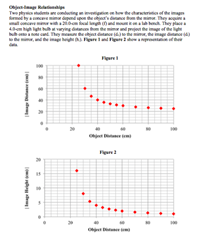 Object-Image Relationships
Object-Image Relationships
Resource:
The Science Reasoning Center: Object-Image Relationships
Grade Level: High School
Description:
This passage describes an experiment in which students investigate the effect of the distance an object is from the mirror upon the height and location of the corresponding image. Data is presented in the form of two graphs. Questions target a student's ability to identify the effect of one variable upon another variable, to select values and to compare values on a graph, to draw conclusions that are consistent with a data presentation (or two), to combine data from two graphs in order to identify an accurate conclusion, and to interpolate using values on a graph.
This activity aligns with the three dimensions of the Next Generation Science Standards in the manner described below:
| Patterns: Empirical evidence is needed to identify patterns. |
If empirical evidence is needed to identify patterns, then it is the graph of this empirical data that is often the means by which these patterns come to light. This point is clearly illustrated in the pair of graphical representations of data displayed in this passage. Students are able to clearly see an inverse relationship between object distance and image distance as well as between object distance and image height. Students are then asked to use these patterns to make predictions as they interpolate between and extrapolate beyond the data presented. |
| Scale, Proportion, Quantity: Algebraic thinking is used to examine scientific data and predict the effect of a change in one variable on another (e.g., linear growth vs. exponential growth). |
As students consider two graphical representations presented in this passage, they must use algebraic thinking to predict the effect that changing one variable has on another. While two inverse relationships emerge, students encounter graphs that have non-zero asymptotes. The meaning of these asymptotes is explored in passage-end questions that ask students to extrapolate beyond the range of collected data. |
| Developing and Using Models: Develop or use a model based on evidence to illustrate the relationships between systems or between components of a system. |
Models can be pictures, graph, equations, analogies, or physical constructions that are used represent a relationship or idea. In this passage, students are asked to use and generate a model that illustrates the relationship that exists between object distance and image distance as well as between object distance and image height. The passage shows student-collected data displayed in a graphical manner to illustrate each relationship. Students use these models to summarize general relationships and to make predictions for new situations. |
| Analyzing and Interpreting Data: Analyze data using tools, technologies, and/or models (e.g., computational, mathematical) in order to make valid and reliable scientific claims or determine an optimal design solution. |
Several of the passage-end questions ask students to analyze and interpret data presented in the form of two graphs. Questions target a student's ability to identify the effect of one variable upon another variable, to select values and to compare values on a graph, to draw conclusions that are consistent with a data presentation (or two), to combine data from two graphs in order to identify an accurate conclusion, to interpolate using values on a graph, and to extrapolate beyond the data displayed. |
Associated Reading from The Physics Classroom
Other Supporting Pages at The Physics Classroom:
View Infographic.
(Coming Soon)
Search the NGSS Corner
Maybe you're looking for something really specific that pertains to a desired topic and emphasizes one or more of the listed NGSS dimensions. Why not try a search of this section of our website? Simply select from one or more of the pull-down menus and click Search This page will reload and a collection of possibilities will be displayed in this section of the page and sorted by relevancy.